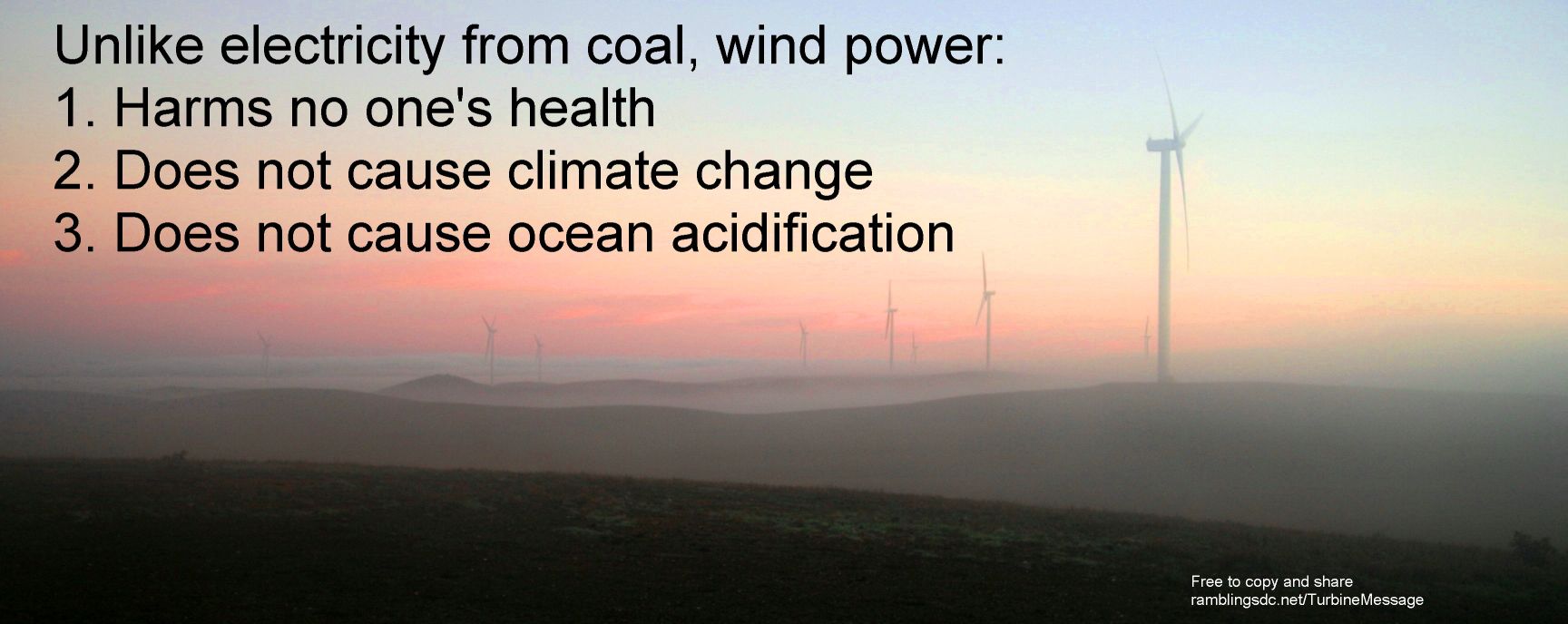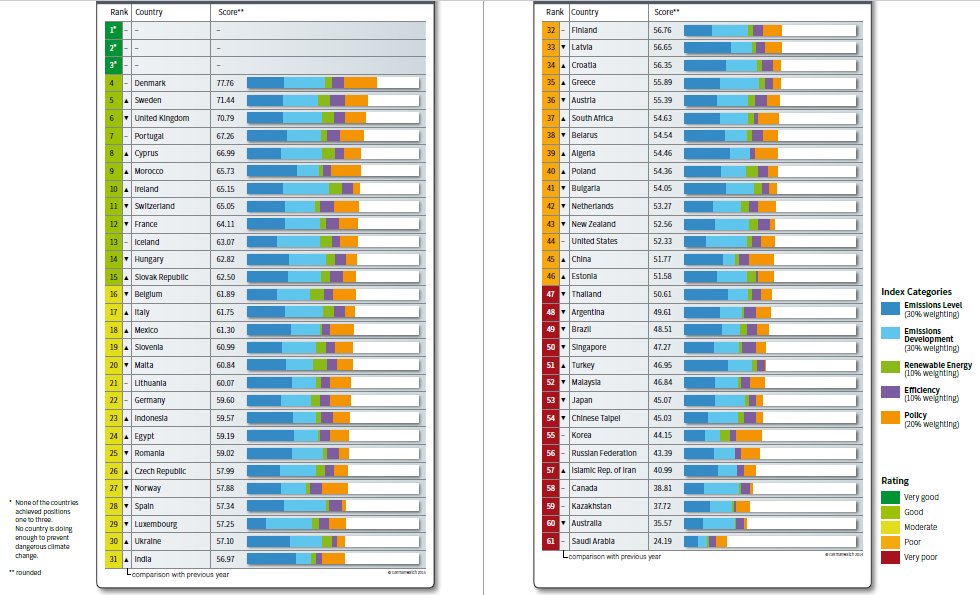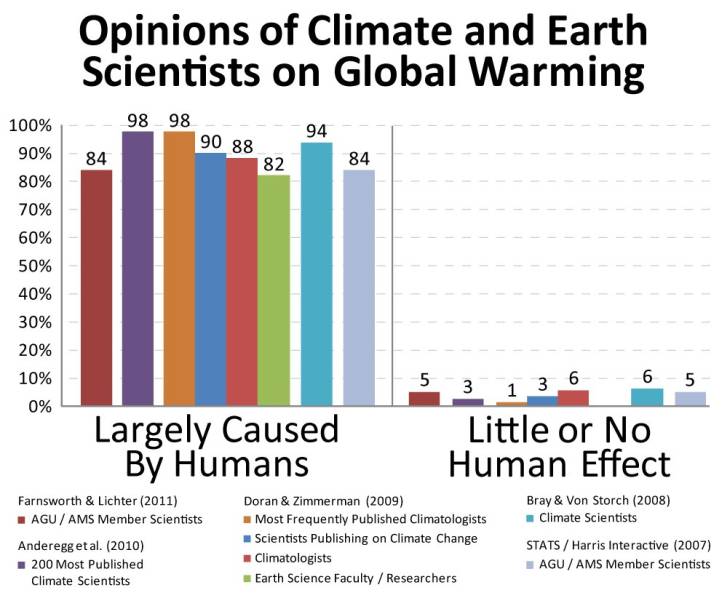| |
| Emissions from fuels in Australia
|
|---|
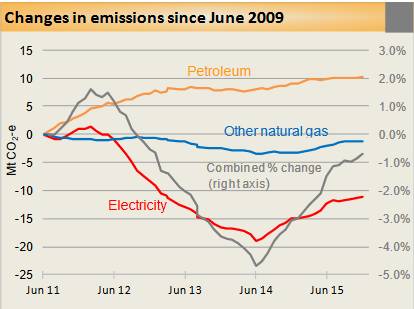
| | Graph credit CEDEX report by Pitt and Sherry
| |
The above graph shows Australia's performance on climate change.
The report also went into climate change policy, in which the comment about
Australia was:
"Since joining the "very poor" group last year, Australia has lost even
more ground and now comes in last together with Canada and Turkey."
The graph on the right, is from the
CEDEX (Carbon Emissions inDEX) report from data to February 2016.
It clearly shows that during the period in which the Carbon Tax was in force,
from July 2012 to July 2014, total
emissions from fuels (the grey line on the graph) fell
steeply and then rose steeply when the Abbott Coalition Government repealed
the Carbon Tax.
The repealing of the Carbon Tax, which the graph indicates was highly
effective at reducing emissions from the Australian energy sector, was a
crime against the younger people of
Australia and the world, and a crime against future generations.
The increased emissions since the repealing of the carbon tax, which could
easily have been avoided (by keeping the Carbon Tax in force), are convincing
evidence of this crime.
Wind power is
popular,
effective,
reduces greenhouse gas emissions and
saves lives by displacing polluting
coal-fired power stations, yet the Liberals are set against it.
Surely the only reason could be that they are being lobbied by the fossil
fuel industry who provide the Liberals with major campaign donations?
| |
Is there any other major political party, anywhere in the world, that
actively opposes renewable energy?
I'd be interested if any reader could tell me of another major political
party anywhere in the Western World, or for that matter, anywhere in the
whole world, that actively works to stop the development of sustainable
energy.
Possibly the Republican Party in the USA?
About half the Liberals in Federal Parliament reject climate change science.
See listings (for all parliamentarians) on the
Lower House and the
Senate.
(February 2013).
|
|
|
|
|
If the Liberals don't want renewable energy, what do they want?
The Liberal Party is forward in its opposition to wind power, but
reticent in stating what they will use instead.
Will they build more polluting
coal-fired
power stations?
Will they build gas-fired power stations (gas is very expensive and is still
polluting, but less so than coal)?
Or will they build nuclear power stations?
None of these alternatives are sustainable or environmentally acceptable.
( Rowan Ramsey, Federal Liberal Member for
Grey, seems to prefer coal.)
|
|
|
|
|
Leaked documents reveal fossil fuel influence in White Paper
The ABC's Andrew Fowler
reported,
after reading leaked meeting minutes,
that the Howard Government's Energy White Paper was heavily influenced by the
fossil fuel industry and the big energy users while the renewable energy
industry was not even made
aware of the meetings that were taking place.
|
|
|
|
|
Wind power a great success in SA
In early 2003 SA had no sustainably generated electricity at all.
In 2011 around 26% of SA's electricity was generated by sustainable
wind power, the amount of greenhouse gas produced by the power generation
industry had decreased by a similar amount, and the amount of power that SA
imported from the eastern states had substantially diminished.
At the same time, power consumption in SA had increased.
(Data from Australian Energy Market Operator; see
more here.)
|
|
|
|
|
|
13 square kilometre exclusion zones
A circle of 2km radius has an area of about 13 square kilometres, so in
states where it is law that turbines not be built within 2km of houses
every house will be surrounded by a 13km2 exclusion zone.
This will put big gaps in many proposed wind farms and make most areas
that would otherwise be well suited to wind farming unviable.
|
|
|
|
|
The saddest thing
The saddest thing about the anti-renewables stance of the Liberals is that it
shows a complete abandonment of
ethical principals in favour of some
other agenda.
|
|
|
|
|
Unintended consequences
The decision of the
Victorian Liberal Government to disallow wind turbines
being built within 2km of homes without the home-owner's agreement seems
to have had unintended consequences.
Construction of five
wind farms has been brought forward so as to avoid having to gain
approval under the new laws.
These wind farms might not have been built for months or years had the
Victorian Government not changed the laws.
|
|
|
|
|
True cost of coal
Climate Progress published an
article that discussed the true cost
of coal when the economic, health and environmental costs are all taken into
account.
The original research was published in the Annals of the New York
Academy of Sciences by Dr. Paul Epstein.
It was calculated that if the true costs of coal was considered the price
of electricity from coal fired power stations would rise by about 18 cents
per kilowatt-hour (or $180/MWh).
This is far higher than the wholesale price of electricity currently paid
to coal-fired power producers.
|
|
|
|
|
Organised political opposition to wind power in the USA
Suzanne Goldenberg wrote a
piece for The Guardian titled "Conservative
thinktanks step up attacks against Obama's clean energy strategy", 2012/05/08.
"The proposals suggest setting up 'dummy businesses' to buy anti-wind
billboards, and creating a 'counter-intelligence branch' to track the wind
energy industry.
A network of ultra-conservative groups is ramping up an offensive on multiple
fronts to turn the American public against wind farms and Barack Obama's
energy agenda."
The strategy proposal has been linked to the American Tradition Institute,
which sounds rather like a US equivalent to Australia's
Institute of Public Affairs,
which, of course, is closely linked to the Liberal Party.
|
|
Australia ranks 53
rd in the world in population, but sixth in the
world in the CO
2 produced by its electricity industry; it has
0.3% of the world's population, but produces 1.5% of the
world's greenhouse gasses; it is well up among the worst
greenhouse
polluters on the planet.
This gives Australians an
ethical
responsibility to reduce the harm we are doing to the planet.
The Federal Labor government is not doing a lot to reduce our greenhouse
gas production rates, but after much
dithering and mind-changing they finally legislated for a carbon tax to
start in July 2012.
The other major force in Australian politics, the Australian Liberal Party,
are steadily becoming more strident in their statements indicating they
don't want to do anything at all about reducing Australia's greenhouse gas
emissions.
In the long run it seems likely that wind and solar power will be cheaper
than burning fossil fuels, so the Liberals will quite probably find out
that by backing fossil fuels they have bet on the wrong horse.
The Europeans have long been leaders in attempts to reduce their climate
change impact.
While the Federal US government is doing little, much is
being done in the USA at the state level.
China is by far the leading nation in the world at present in construction
of new wind farms as a way of reducing its reliance on fossil fuels and
limiting greenhouse gas production.
The nations with a high per-capita rate of greenhouse gas production are
the ones that have to accept most of the blame for climate change, while
those that suffer the most from climate change will be the poorer nations
like those of SE Asia and the pacific.
(Several decades ago we could have claimed that we didn't know we were
causing climate damage as an excuse for inaction; we no longer can.)
Does Australia risk becoming an international pariah if the Liberals get into
government and stop all action to
improve Australia's
position on climate change?
Most Australians want action on climate change; are they willing to support
a political party that wants to do nothing?
Those who do will be as culpable as the Liberals themselves.
The Liberals in three Australian states have now come out in support of
mandating no wind turbine being built within 2km of a home without the home
owner's approval.
Many people in Australia and around the world are living very happily much
closer to wind turbines than that.
There should be, and are, laws about maximum sound levels from turbines at
homes, but a mandatory
2km limit is foolish,
not supported by the
evidence and will greatly limit renewable energy development in Australia.
It is proven that the emissions from coal-fired power stations damage people's
health and cost people's lives.
By making the building of wind farms unviable the Liberals will be responsible
for thousands of
unnecessary serious illnesses and hundreds of unnecessary deaths each
year.
The USA is the only country in the OECD that has similarly high greenhouse
gas production rate, per capita, as Australia.
The Federal US administration has generally been slower to act than some
of the states; however there are signs that even the US is moving ahead.
Reported by The Climate Institute, 2012/03/29:
The U.S. Environmental Protection Agency has for the first time proposed
limits on carbon pollution from new power plants.
(The EPA is required to regulate CO2 emissions from power plants by the
U.S. Clean Air Act, due to the threat to health and welfare caused by carbon
pollution. This was confirmed by the U.S. Supreme Court in 2007.)
The EPA has proposed that new power plants may emit no more than 1000lb
(363kg) of CO2 per megawatt-hour (MWh) of electricity produced.
This standard permits combined-cycle gas plants, which emit 800lb CO2 per
MWh, but it effectively precludes the construction of any new coal-fired
plants unless they include carbon capture and storage.
(The standard explicitly excludes open-cycle gas plants used to meet peak
demand.
For more detail, see http://epa.gov/carbonpollutionstandard/actions.html.)
| |
| Wholesale electrcity prices
|
|---|
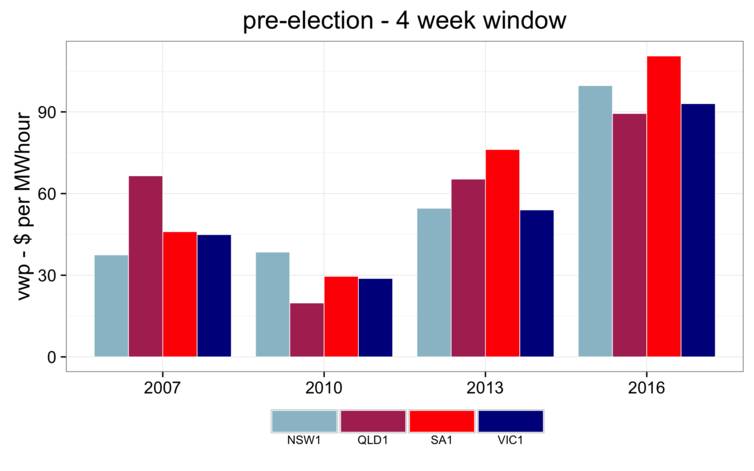
| | Graph credit: The Conversation
| |
A piece by Mike Sandiford titled "Electricity prices, the election agenda and
the case for bipartisanship" was published on
The Conversation on 2016/06/22.
It included the graph on the right which shows how the price of electricity
has substantially increased since the abolition of the carbon tax.
This, of course, is totally the opposite of what the Abbott/Turnbull
governments said would happen.
They blamed the carbon tax for pushing up electricity prices and said that
when the tax was abolished power prices would fall.
The caption beneath the graph on The Conversation article was:
"Wholesale electricity prices in the 4 week period prior to the last four
Australian federal elections.
For the 2016 election cycle, the period is 23rd May – 20th June.
For the previous three elections it is the 4 week period finishing on the
election day.
Prices are volume-weighted and differentiated by the region.
Data from AEMO half-hour aggregated price and demand tables."
| |
| Wholesale electrcity prices
|
|---|
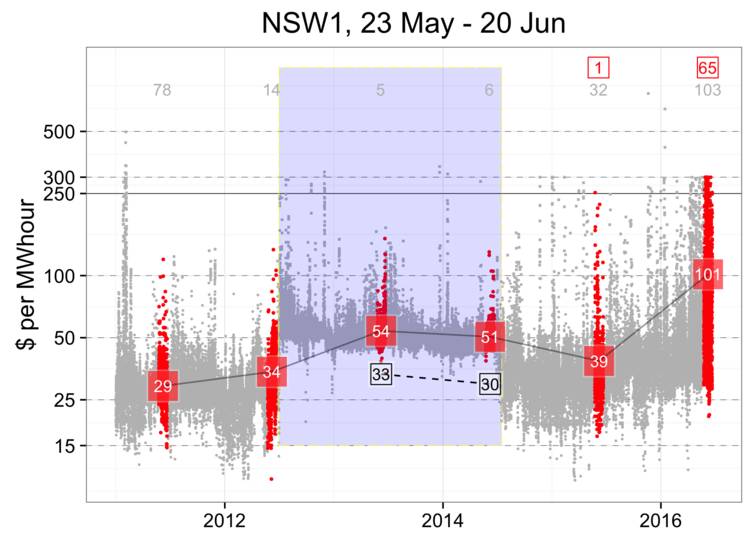
| | Graph credit: The Conversation
| |
This graph, also from The Conversation article, shows that wholesale
electricity prices have risen substantially in NSW since the abolition of the
carbon tax – the coloured section of the graph.
The caption for this graph on The Conversation:
"Half-hour trading interval prices for NSW, from 2011 on.
Red colours highlight the 4-week period 23 May – 20 June, with volume
weighted prices in red boxes.
The period of carbon pricing is shown in purple shading.
Black boxes show the prices adjusted by removing the carbon prices assuming
an emission intensity of 0.9 tonnes per megawatt hour.
Units are dollars per megawatt hour.
Numbers along the top indicate the number of intervals when prices exceeded
$250 per megawatt hour in grey for the calendar year, red for the 4-week
period."
Again, by far the highest electricity prices have been in the most recent
4-week period.
March 2013; Australia's hottest summer on record has just finished
yet half of our Federal Liberal politicians say it isn't happening!
|
This section was written before the federal election of September 2013.
Please note that this is extracted from a posting by uknowispeaksense (see
the bottom of the table).
|
| Liberal politicians' stance on climate change science
|
|---|
| Deniers | Accepters
|
|---|
| House of Representatives | Senate | House of Representatives
| Senate
|
|---|
| Abbott, Tony | Abetz, Eric (Tas) | Alexander, John
| Birmingham, Simon (SA)
|
| Andrews, Karen | Back, Christopher (WA) | Billson, Bruce
| Boyce, Sue (Qld)
|
| Andrews, Kevin | Bernadi, Cory (SA) | Briggs, Jamie
| Brandis, George (Qld)
|
| Bishop, Bronwyn | Bushby, David (Tas) | Broadbent, Russell
| Cormann, Mathias (WA)
|
| Gash, Joanna | Cash, Michaelia (WA) | Buchholz, Scott
| Fifield, Mitch (Vic)
|
| Haase, Barry | Edwards, Sean (SA) | Ciobo, Steven
| Heffernan, Bill (NSW)
|
| Hawke, Alex | Eggleston, Alan (WA) | Fletcher, Paul
| Humphries, Gary (ACT)
|
| Jensen, Dennis | Fawcett, David (SA) | Frydenburg, Josh
| Payne, Marise (NSW)
|
| Jones, Ewen | Fierravanti-Wells, Concetta (NSW) | Hockey, Joe
| Smith, Dean (WA)
|
| Keenan, Michael | Johnston, David (WA) | Hunt, Greg |
|
| Kelly, Craig | Kroger, Helen (Vic) | Irons, Steve |
|
| Matheson, Russel | MacDonald, Ian (Qld) | Laming, Andrew |
|
| Mirabella, Sophie | Mason, Brett (Qld) | Ley, Sussan |
|
| Ramsey, Rowan | Parry, Stephen (Tas) | Macfarlane, Ian |
|
| Randall, Don | Ronaldson, Michael (Vic) | Marino, Nola |
|
| Robb, Andrew | Ryan, Scott (Vic) | Morrison, Scott |
|
| Robert, Stuart | | Moylan, Judi |
|
| Schulz, Alby | | O'Dwyer, Kelly |
|
| Secker, Patrick | | Prentice, Jane |
|
| Simpkins, Luke | | Pyne, Christopher |
|
| Wyatt, Ken | | Roy, Wyatt |
|
| | Ruddock, Philip |
|
| | Smith, Tony |
|
| | Southcott, Andrew |
|
| | Stone, Sharman |
|
| | Tehan, Dan |
|
| | Tudge, Alan |
|
| | Turnbull, Malcolm |
|
| | Washer, Mal |
|
|
Source: Lower House,
Senate (uknowispeaksense – You know I speak sense).
Data extracted for the above table in February 2013.
|
|
|
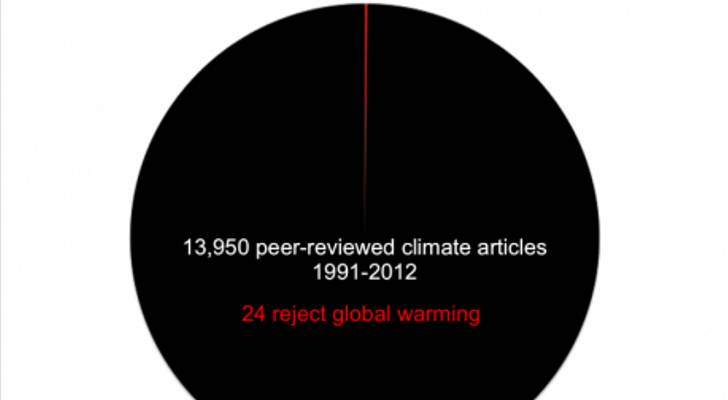
| | Graphic credit: James Lawrence Powell
| |
The pie chart on the right shows graphically what climate scientists have
been trying to tell us for years; that the science of climate change is
settled.
There's about as much doubt about global warming as there is about whether
the Earth is flat or round.
While the graph above shows how the vast majority of climate scientists
accept that the climate is warming, the one on the right shows that the
vast majority of climate and earth scientists accept that global warming is
largely caused by Mankind.
But about half Australia's federal Liberal politicians would have us
believe that they know better!
My interpretation of the Liberal's message goes something like this...
"We don't want to see any form of subsidisation of renewables, nor risk the
huge profits being generated by the coal industry.
We don't necessarily believe what the vast majority of climate scientists
are telling us, but if there is six degrees of climate change by the end
of the century and the planet is stuffed, well hell, we've helped some of
our very wealthy supporters to make a huge pile along the way!
Anyway, we are not really against renewable energy, we would be very happy
to support renewables if they could compete with fossil fuels and be available
on tap, and they didn't get in the way of the profitability of coal.
(Never mind the
unfair advantage that the fossil fuel industry has in being able to dump
its pollutants into the atmosphere at no cost to itself.)"
This was developed during extensive reading of Liberal statements on wind
power and a very limited exchange of emails with
Senator Sean Edwards.
January 2013; It seems that Tony Abbott's new policy
advisor Maurice Newman hates wind power, denies climate change and doesn't
trust science.
He squeezes nine inaccuracies or fallacies into one sentence
Mr Newman has a
page to himself on this site.
| |
As a self-funded retiree of moderate resources, I am a little concerned
about possible legal action when I point out false statements from someone
like Maurice Newman.
While I believe that one cannot be guilty of libel if what one says about a
person is true, there is still the possibility of an expensive legal action
that might be needed to prove the point in court.
In the MN case, I doubt very much that he would bring an action, because:
- he would know that he cannot substantiate his claims;
- he would know that I can prove my claims;
- he can see that I am criticising him from an ethical position and on
ethical grounds;
- it is in the public interest that lies like his be exposed;
- he would know that he could not win and he would know that I know that
he could not win;
- the negative publicity would be very harmful to him and the Liberals.
I believe that we all have an ethical responsibility to 'call-out' those
people who are maliciously spreading fallacies about the renewable energy that
we must adopt in order to slow the damage caused by climate change.
|
|
The following was published in
Climate Spectator regarding
a new Prime Minister's Business Advisory Council to advise the Executive
Government, supposing that the Liberals get into government.
The Council is to be headed by Maurice Newman.
(The boxes on the right contain my comments.)
On wind power Mr Newman wrote in the publication The Spectator (not associated
with Business or Climate Spectator) on January 21, 2012:
| |
Impressive, nine fallacies in one sentence!
I have placed links on seven of the 'errors' on the left.
The links will take readers to an explanation of the facts.
Then there are two more inaccuracies: wind farms are less 'socially inequitable' than other forms of energy generation, consider
community funding for
example, and wind farms are much less environmentally harmful than coal,
coal-seam gas, gas and nuclear.
Whether they are a 'blot on the landscape' is subjective.
|
|
"Even before they threatened my property, I was opposed to wind farms.
They fail on all counts.
They are grossly
inefficient,
extremely
expensive,
socially inequitable, a danger to human
health,
environmentally harmful,
divisive for communities, a blot on the landscape, and don't even achieve
the purpose for which they were designed, namely the
reliable
generation of electricity and the
reduction of CO2
emissions."
On the issue of whether human activity is leading to warming of the
atmosphere he wrote in The Australian on November 5 last year:
| |
The IPCC is composed of climate scientists.
There is a
strong consensus among
climate scientists about anthropogenic climate change.
It seems Mr Newman either doesn't trust science or doesn't understand
how it works.
|
|
"When Mother Nature decided in 1980 to change gears from cooler to warmer,
a new global warming religion was born, replete with its own church (the
UN), a papacy, (the Intergovernmental Panel on Climate Change), and a global
warming priesthood masquerading as climate scientists."
|
Mr Newman was quoted in the UK Guardian as claiming that 'global warming is
"somewhat in tatters" so there was no longer any logical reason' for
renewable energy. (2013/06/16)
Of course this is nonsense, there is no doubt that anthropogenic
climate
change is a fact and that it will lead to disastrous outcomes for the
planet.
That a man with such opinions and capable of such lies could ever be a chief
advisor of a Prime Minister of Australia is depressing, even disgusting.
| |
Mr Newman does not have lack of information as an excuse for his lies on
wind power.
He is a member of the Community Consultative Committees for the
Crookwell wind farms.
|
|
If Australia was to follow the opinions of people like Mr Newman it would
put us very much out of step with our trading partners who recognise the
value of sustainable energy, wind power in particular; for example the
USA installed a record 13.2GW and
China 14GW of wind power in 2012.
(Australia's total wind power at the end of 2012 was 2.7GW.)
Australia will be left behind with the most climate-polluting power generation
system in the developed world.
Not only does Maurice Newman seem to be a highly questionable choice as a
senior advisor, but
in April 2013 Tony Abbott had to demote another of his advisors following
a 'drunken brain snap'.
Mr Abbott's director of policy, Dr Mark Roberts, was demoted when he told
Australian Indigenous Education Foundation chief Andrew Penfold that he
would "cut his throat" when the coalition won government.
Surely one of the most valuable qualities in any (potential) national
leader is the ability to choose advisors and assistants wisely and well.
It seems that this is a quality that Tony Abbott is lacking.
| |
| The Liberals prefer coal to wind.
Perhaps they'd like Australian cities to look like this; so long as they had
plenty of money in their pockets?
|
|---|
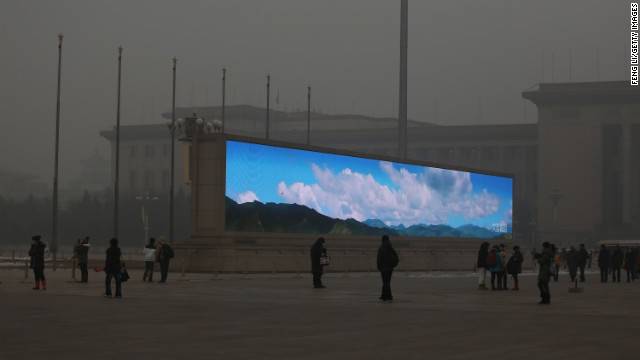
| Beijing people are reminded what a clear sky looks like by
a big screen
Image credit: Feng li/Getty Images
We can learn a lot from China; they have huge environmental damage, but
they are making equally huge steps toward adopting sustainable energy.
| |
Signs that the Liberal Party is dominated by
climate science
deniers and lobbyists from the fossil fuel industry are becoming
increasingly conspicuous:
- Famously (or infamously)
Leader of the Federal Opposition Tony Abbott has said that "Climate change is
crap" and the Federal Opposition is implacably opposed to PM Gillard's carbon
tax while not having an alternative policy to lower greenhouse gas
production that any economist or environmentalist seems willing to support.
Mr Abbott has also proposed to abolish the Climate Commission.
- In August 2013, ahead of the September election, Tony Abbott vowed to
abolish the Clean Energy Finance Corporation if elected.
- In August 2011 the Baillieu Victorian Liberal government placed in force
new laws that will make
further wind power development in that state very difficult;
-
Around the same time
NSW Premier Barry
O'Farrell said on radio that "if I
had my way, we wouldn't [approve any applications for wind farms in NSW]";
- Also in August the WA Liberal Party voted 'by an overwhelming
majority' for a Royal Commission into climate change science –
indicating that they were not convinced that it is real.
- In September 2011 rumours were circulating that
Isobel Redmond, Leader
of the
(Liberal) Opposition in South Australia, was considering introducing laws
like those in Victoria
when and if she gains power.
At the same time SA Shadow Minister for Energy Mitch Williams was using the
inability of solar and wind power to provide
peak load power as a way of
devaluing sustainable energy, both in response to my written inquiry and on
ABC radio.
This seems to be a political ploy to make voters think that sustainable
energy has serious short-comings, while the fact is that
the power supply system can easily
cope;
-
To cap it all off, in December 2011 the SA Liberals announced their
wind farm policy in a flyer.
| |
| Clean energy: turbines and trees at Waterloo Wind Farm
|
|---|

| | This photo was taken before I
slept under one of the Waterloo
turbines.
| |
It is Federal Liberal Party policy to support "a
twenty
percent renewable energy target"; however their environmental
policy document does not mention a target date.
If they gain government will they retain the
20% by 2020 renewable energy plan put in place by the Rudd Labor Government,
or will they change the target date to 2025 or 2030 or even later?
I inquired in early October (2011), but significantly have not received a
reply.
In any case, even if a Liberal Federal Government was to retain the 20% by
2020 target, where could the wind farms be built if Liberal governments in
the states stand against renewable energy?
| |
|
This section added 2012/10/18
|
|
| |
| Declining emissions attributed to the carbon tax
|
|---|

| | This graph was compiled from Australian Energy Market
Operator data and published in the Sydney Morning Herald.
| |
Tony Abbott has promised to abolish the carbon tax.
As I write this section the tax has only been in effect for a few months, but
it seems to have already resulted in the carbon intensity of the National
Electricity Market (NEM) electricity falling from about 0.9 tonnes of CO2
per MWh down to 0.85.
This is a good result at such an early time.
It shows that effective action on climate change is quite possible so long
as there is a will.
(In fact far more could be done especially if the Federal Government was to
stop compensating and subsidising the fossil fuel industry.)
So, if an Abbott government is elected, we can expect to lose this small but
significant step in the right direction.
Thanks to RenewEconomy for making this news public.
Victorian Health Minister complains about $6 billion savings costing $13 million
An article in the
Brisbane Times, 2012/08/14, by Julian
Drape showed the degree of bias against renewable energy and action on
climate change in the Victorian Government.
Quoting from the article...
Tony McMichael, from Australian National University's College of Medicine,
said ... "recent claims by Victoria's Liberal health minister, David Davis,
that the carbon tax would add $13 million a year to the cost of running the
state's hospitals ... were 'appalling', 'ignorant' and 'mischievous'
because $13 million was a trivial 0.1 per cent of the state's annual spend."
"You can see the crudeness of that political exploitation of a society that
is trying to take initial and useful steps to slow climate change in order to
avert risks," he said at the launch of a report which suggests shifting to
cleaner energy and transport could save the Australian community $6 billion a
year in avoided health costs.
"A minister of health who holds or promulgates that sort of view ... is not
fit to be a minister of health."
I have written a page on how
wind turbines save lives elsewhere on this site.
|
|
| Hazelwood coal mine fire, February 2014
|
|---|
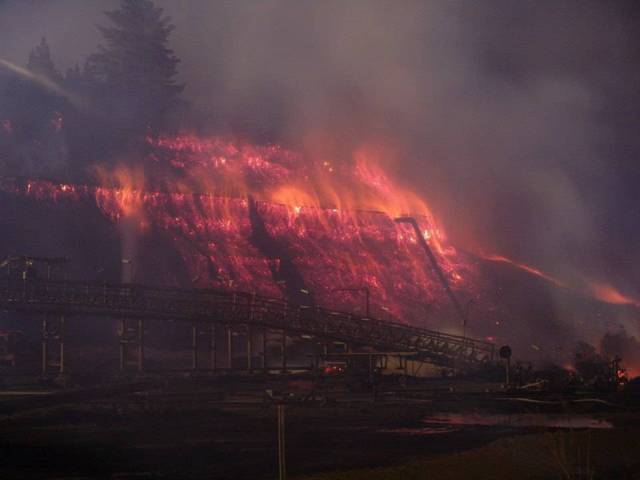
| It seems that the Victorian Liberal government are quite
happy to have coal mines in this area, even when they are run incompetently,
but wind turbines are against the law.
Does the reader see any ethical problems with laws like this?
Image credit 350.org
| |
Victoria was the first Australian state, and probably the first government
anywhere in the world, to outlaw the building of a wind turbine within
2km
of a house without the consent of the owner of that house.
There is no rational basis for this legislation (other than an apparent
desire to stop the development of sustainable energy and thus support the
fossil fuel industry); sound levels should
govern how close wind turbines can be to homes.
(I have written more about the specifics of the laws on the
Victoria wind power
page.)
At the same time as bringing in the 2km law, the Victorian government
proclaimed a number of 'no-go zones' for wind turbines.
These seem to have been arbitrarily decided by someone in the Liberal Party
and justification for their locations has never been forthcoming (see below).
ABC
| |
The cost of Baillieu's policy
Friends of the Earth have produced a
document outlining the cost of the
Victorian government's anti-renewable energy laws including $887m in lost
and stalled investment, 650 direct jobs and projects totalling 204 turbines
and 408MW of generating capacity.
|
|
In an article by Anthony Steward on ABC On-line news, 2012/02/17, energy
analyst Kobad Bhavnagri pointed out that the Victorian rules would push
energy prices up.
The logic is simple; we must move to renewable energy, wind power is the
most practicable of the available options and if the best places to build
wind farms are ruled out then they must be built elsewhere at higher prices
or you have to go to other, more expensive, forms of renewable energy.
Of course it is the consumers who ultimately pay the bill.
The ABC requested a comment from Planning Minister Matthew Guy, but received
no response.
The ABC World Today's Anthony Stewart reported on 2012/02/17:
"Six months after the Victorian Government brought in strict rules on wind
farms, there are warnings the laws are forcing the industry out of the state.
Since the guidelines were introduced no new wind farm energy projects have
been proposed and the future of several existing projects is in doubt.
There are fears Victoria will miss out on billions of dollars in investment
and potentially force up the price of electricity."
Environmental Defenders Office
|
|
|
Wind turbines save lives by replacing
coal-fired power generation which is a major producer of atmospheric
pollution causing hundreds of deaths and thousands of serious diseases
each year.
|
|
Michael Power wrote an article in the
Climate Spectator entitled "Coal or wind in your back yard".
The article was about a report released in the week ending 2012/04/27 by
the Victorian Environmental Defenders Office.
It states that the new wind farm laws "make it easier to obtain approval for
a coal mine than a wind farm in Victoria."
It also says that, as the same time as making it harder to build wind farms
"the government has moved to relax the laws that apply to new mining
projects".
Victorians call for action on climate change
Adam Morton wrote an article under this headline in The Age, 2012/03/09:
"The Essential Media poll of 1009 Victorians, commissioned by conservation
group Environment Victoria, found 76 per cent believed the state government
should cut emissions and not leave it to the federal government to take
action through a carbon tax or other steps.
Among Coalition voters, 66 per cent said the state had a responsibility to
cut emissions."
Another finding from the poll was that "just 22 per cent of voters consider
wind farm laws that give householders right of veto over turbines within two
kilometres of their house fair" and "50 per cent said the laws were not fair".
"A majority said they wanted fewer coal-fired power plants (63 per cent)
and more renewable energy (78 per cent) and energy efficiency (82 per cent)."
So it seems that the Victorian Liberals are 'backing the wrong horse'
in supporting the fossil fuel industry against sustainable energy.
Victorian rules mystify Danes
|
|
|
Denmark has more wind power per capita than any other nation and Denmark is
home to Vestas, a wind turbine construction company.
Vestas has built turbine components in Australia in the past, but the
sustainable energy industry under the Howard Government was so uncertain that
the plant closed-down.
| |
The following was reported in the Sydney Morning Herald, 2011/11/26;
"The head of the world's largest wind energy company has questioned the
Baillieu government's rationale for giving households veto rights over
turbines within two kilometres of their homes.
Ditlev Engel, chief executive of Danish company Vestas, said he had "no idea"
where the policy had come from.
Mr Engel, who is visiting Victoria with Crown Prince Frederik and
Tasmanian-born Crown Princess Mary, said no one had explained the motivation
for Victoria's most restrictive regulations on turbines.
In Denmark, when you have a wind turbine, in order to get approval, you need
to be four times the height of the tip (away from a house).
The tip height is 150-200 metres, so the distance from the turbine to where
people live has got to be 600-800 metres.
And that's fine."
The parts of
Victoria
that have the best wind resources are fairly populated by Australian rural
standards.
If anyone having a home within 2km of a proposed turbine can veto the
construction of that turbine it will be very difficult to build any more
wind farms in the state.
|
|
| Wind turbine on Salt Creek Hill
|
|---|
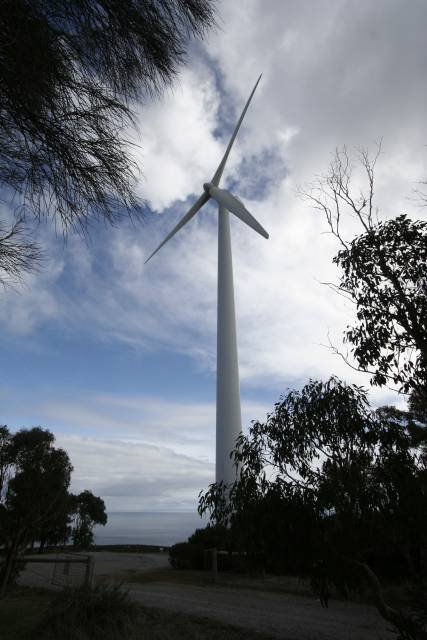
| | One of the turbines of Starfish Hill Wind Farm
| |
Reneging on election commitment
Energy Matters reported on 2012/03/28 that
"The Victorian Government has reneged on election commitments of a 20%
carbon emission reduction target and capping emissions from new coal fired
power stations.
The carbon emissions reduction target has been slashed from 20% to just 5%.
The news comes just a week after The Age revealed the Baillieu government
is preparing a campaign to promote development of Victoria's brown coal
reserves."
Victoria's brown coal, weight for weight, is some of the most polluting
in Australia.
Liberal MP does about-face on wind power
Royce Miller wrote an
article in The Age, 2012/02/22, about
Victorian Liberal MP Simon Ramsey.
Mr Miller wrote of Mr Ramsey:
"His campaign against the
Mount Gellibrand wind farm has
involved a remarkable personal shift – in the mid-2000s was a vocal
champion of wind energy and obtained permits for turbines on a parcel of his
own land, which he has since sold.
His recent activism has included campaigning against turbines for which
he previously held permits."
Mr Ramsay has been accused of misusing his position.
It seems to me that Mr Ramsay has been pressured by the Liberal hierarchy,
or directly by the fossil-fuel interests that seem to have so much power over
the Liberal Party, to change his stance.
Where did the 'no-go zones' come from?
In an
article in Yes2Renewables written by Cam Walker, Liberal MP Donna
Petrovich, Parliamentary Secretary for Sustainability and Environment,
is asked to explain the 'no-go zones' in which wind farms will
not be allowed.
Petrovich has said that the "No Go zones were carefully selected where
communities 'on the whole have
told us that they are not appreciative of wind farms'".
Cam Walker has asked Ms Petrovich to justify this claim, given the fact that
surveys have shown a high level of
popular acceptance
for wind power.
Ms Petrovich has not replied.
Ms Petrovich's email address is 'donna.petrovich@parliament.vic.gov.au'.
I have asked her to justify her statement, and urge readers to do the same.
In early 2012 NSW Planning Minister Brad Hazzard announced plans to make the development of wind farms much more difficult.
The NSW plans were similar to those enacted in
Victoria in August 2011.
| |
| Korean fan-death warning
|
|---|
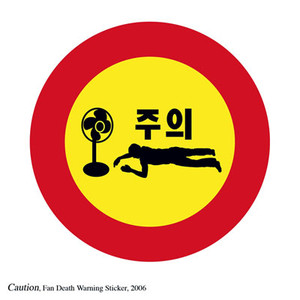
|
NSW State Planning Minister Brad Hazzard told the Sydney Morning Herald on 2012/01/24: "The jury is still out on the health impacts from wind farms. When it comes to people's health I'll take a precautionary approach every time."
There is a belief among a few people in Korea that fans chop up oxygen molecules and can cause asphyxiation if used in a closed room.
There is just as much scientifically credible evidence for this belief as there is for the "wind turbine causes sickness" belief – that is, absolutely none.
Will Minister Hazzard take a precautionary approach and ban fans?
|
|
This was printed in the
Sydney Morning Herald on 2012/01/24:
"FEARS that wind turbines make people sick are ''not scientifically valid'',
and the arguments mounted by anti-wind farm campaigners are unconvincing,
according to confidential briefings given to the state government by NSW
Health.
Documents obtained under freedom-of-information laws show that health
officials repeatedly warned ministers last year that there was no evidence
for ''wind turbine syndrome'', a collection of ailments including
sleeplessness, headaches and high blood pressure that some people believe
are caused by the noise of spinning blades.
But the department's advice contrasts with the view of the Planning Minister,
Brad Hazzard, who was responsible for draft guidelines, released in December,
that significantly tighten the approvals process."
This information was brought to light by investigations carried out by
Friends of the Earth, including
particularly, Cam Walker.
| |
In September 2012 NSW Energy Minister Chris Hartcher said
"Building a strong renewable energy industry is vital to supporting
employment and helping grow the NSW economy".
NSW now has a target of 20% renewable energy by 2020.
(In 2011 about 8% of NSW's electricity was renewable, with most of that being
hydro from the Snowy Mountains Scheme; NSW has been very slow in adopting
wind power.)
This sudden about-face is difficult to believe.
It is significant that the target date is eight years away and no interim
targets seem to have been set.
The government has left itself the option of putting off most of the action
four years or more.
If they get re-elected they will be able to change their policy putting the
target date further into the future.
|
|
NSW Planning Minister Brad Hazzard decided that he could ignore this
information when he said "the jury is still out on the health impacts from
wind farms".
(Of course he also ignored the fact that
wind turbines save lives by replacing
coal-fired power generation which is a major producer of atmospheric
pollution causing hundreds of deaths and thousands of serious diseases
each year.)
For some of the submissions from people on the NSW guidelines see this
Yes! to renewables page.
Brad Hazzard has said that the NSW guidelines are the "toughest wind farm
guidelines in Australia and possibly the world".
One would have to wonder why he made them so tough, unless he is against
sustainable energy developments?
And then, why is he against sustainable energy development unless he is
looking after the interests of the fossil fuel industry?
"Newly elected [Liberal-National] Queensland Premier Campbell Newman is
expected to move quickly to disband the state's climate change and renewable
energy programs".
This is part of a post on
REnew Economy written by Giles Parkinson
on 2012/03/27, shortly after the election of the new Queensland government.
This would seem to confirm the premise of this page: that the Liberals do
not want to do anything to reduce Australia's shameful rate of greenhouse
gas production.
The previous Labor Government of Queensland supported a huge wind farm at
Hughenden as part of a
renewable energy initiative called the Copper String, but this is not
suported by the new Liberal-National Government.
The Brisbane Times, 2012/06/08, reported that Environment Minister
"Mr [Andrew] Powell repeated a statement he had made to ABC's Radio National
that he was not convinced that humans were having an impact on climate change".
Premier Campbell Newman described his minister's view as "refreshing".
ThinkProgress reported on 2012/07/18
"The latest snapshot on this inglorious race to the bottom came last week
during the Queensland LNP [Liberal National Party] state conference with a
motion proposed by the Noosa LNP member Richard Pearson.
Pearson's motion called on the states education minister John-Paul
Langbroek to "remove environmental propaganda material, in particular
post-normal science about 'climate change', from the curriculum and as
adjunct material at exam time".
The motion was passed with party members overwhelmingly in favour.
More in September 2012
Giles Parkinson wrote a piece in ReNewEconomy on 2012/09/12
listing climate change and clean energy initiatives that Premier Campbell
Newman announced were to be shut-down.
They included:
"the Solar Flagships project ..., the Queensland Climate Change
Fund, the Queensland Renewable Energy Fund, the Queensland Smart Energy
Savings Fund, the Solar Initiatives Package, the Waste Avoidance and
Resources Efficiency Fund, the Local Government Sustainable Future Fund
and the Climate Smart Home Service.
Other projects to be brought to an end are the Solar Hot Water Rebate Scheme,
the Solar Atlas, the Cloncurry Solar Thermal Trial Site Remediation and a
separate Solar PV Farm, the Bright Thing Campaign, the Renewable Energy
Industry Development Plan, and Climate Smart Business Service.
The Wide Bay Community Solar Farm has been deferred."
| |
Liberals have second thoughts?
The first flyer that I received on paper from Liberal Member for Stuart,
Dan van holst Pellekaan's office (and downloaded from the Net) talked of a
five kilometre ban from houses.
On 2012/01/06 I received a second flyer from Hendrik Gout at the office of
David Ridgway, MLC, (Liberal) Leader of the Opposition in the SA Legislative
Council.
Mr Gout said that the original "was prepared specifically to a meeting
held at Allendale" (where there is opposition to a
proposed wind farm).
The second flyer is similar to the original, except it says that the Liberals
will ban a turbine from being built within 2km, rather than 5km, from
a house, without the agreement of the owner, and 5km from a town.
The lies and half-truths in the second flyer remain the
same as in the first.
|
Rowan Ramsey, Liberal Member for Grey
Grey, Rowan Ramsey's electorate, contains many of South Australia's wind
farms.
You might expect that Rowan would praise the wind industry and the
investment, jobs, employment and extra income it has brought to his
electorate.
No, he made a
speech in Parliament throwing as much
mud at the industry as he could dredge up.
|
|
In December 2011 the SA Liberal Party released a flyer running down wind
farms and describing their stance on wind power.
The publication contained several
errors of fact
and was so anti-renewables that it could
have been written by someone in the fossil fuel industry (it certainly
seems that it was written following consultation with the strongly
anti-wind power
Waubra Foundation, from
whom the Liberals got most of the photos for the flyer.)
Of greatest importance this first flyer promised that the Liberals would ban
turbines from being built closer than five kilometres from homes without
agreement from the home owner (the five kilometres was later changed to
two kilometres – the whole thing indicated
shoddy, biased and careless research).
Giving every home owner the right to veto any wind turbine within
two kilometres
of his or her home will make construction of wind farms in many
areas in SA impractical.
Before 2003, when SA's first wind farm at
Starfish Hill was built,
SA had no wind power, but by 2011 SA was generating more than 20% of its
electricity from clean, renewable, wind.
This is a wonderful achievement, making SA a world leader in the fight
against climate change, and all South Australian's should be proud of it.
Wind and hydro power are by a large margin the most viable
forms of renewable energy available at present (the cost of solar is
coming down, but an average utility scale wind
turbine generates about
2000
times as much electricity
as an average roof-top solar installation).
Of course SA has negligible opportunity to develop hydro power, we have far
too little rainfall for that.
If the Liberals make wind power impractical they will greatly limit renewable
power development in SA.
South Australia's
best wind resources are mostly either on the
coast or on ridge-tops within a
hundred kilometres of the coast and it is not financially viable to build
a wind farm a long distance from a power transmission line (which cost around
a million dollars per kilometre to build).
The first anti-renewable energy flyer can be downloaded
here.
Wind-generated power is not expensive
Contrary to the statement on the flyer, wind-generated power is the
cheapest
sustainable energy (with the possible exception of some hydro – which
of course is not an option for SA) and is cheaper than fossil fuel electricity
with carbon sequestration.
There is no evidence that wind farms lower property values.
In spite of a statement to the contrary in the flyer a number of studies have
indicated that while
property values might drop
slightly during and shortly after wind farm construction, there is no
long-term loss, and land that has turbines on it is, of course, more valuable
because of its greatly increased earning potential.
No credible study that I know of has shown a definite and significant
decrease in land values near wind farms.
Wind farms are not noisy
|
|
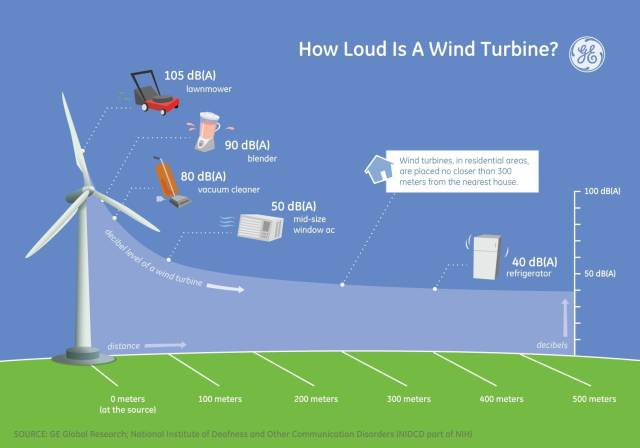
| Image credit General Electric
In Australia wind turbines are very rarely as close as 300m to any houses
| |
The flyer stated "The Clements
[ Gap] and
Waterloo wind farms can be heard three kilometres away."
This is probably true in some places at some times under ideal conditions.
I live 15km from Clements Gap Wind Farm and have visited it many times.
Several times I have stood on a side road 2.5km from the turbines and have
just been able to
hear them when there was no car traveling
on the road within 2 km of me; any car nearer than that drowned-out
the turbine sound.
Also, turbines can only be heard at this distance in the right wind
conditions; a strong wind makes so much noise in nearby vegetation that it
also drowns-out the turbine sound.
I have visited nearly all the wind farms in SA and Victoria, and several of
those in WA; I have never heard a turbine from a distance greater than 2.5km
(correction, on 2013/07/07 I
managed to just hear
some turbines 3.0km away).
Surf on a beach and traffic on a highway can be heard 5km away, thunder even
further; as with wind turbines it is the lower frequencies in the sound that
travel so far.
Most people are not annoyed by this sort of sound.
Wind farms do not cause ill-health
The flyer stated:
"Many people report sleep disruption and nausea.
Peer-reviewed studies show those living over a kilometre from industrial
wind turbines suffered sleep disruption so severe it affected their daytime
functioning and mental health."
| |
|
Professor Simon Chapman, School of Public Health and Teresa Simonetti,
Sydney University Medical School, compiled an extensive
list of the main
conclusions reached in 17 reviews of the research literature on wind
farms and health; all showed no direct link between ill-health and wind
turbines.
|
|
These are half-truths at best (I haven't come across any peer-reviewed papers
published in respectable journals that said any such thing).
Far more people who live within a few kilometres of turbines are not
bothered by them; see
Wind farms and health.
The Liberals did not comment on all the research that shows no harm from
wind turbines other than annoyance and some loss of sleep when
turbines are poorly sighted.
The pollutants from
burning fossil fuels are incomparably
more damaging to human, animal and environmental health than are wind farms;
the Liberals neglected to make this point.
Fire
Wind turbines are much less of a
fire hazard than farm machinery.
The worst that has happened in Australia is a few spot fires that were
started from a turbine fire at Cathedral Rocks in
2009, but little bush was burned and there was no damage to infrastructure
other than the turbine itself.
Of course the flyer did not say that a row of wind turbines along the top
of a ridge will reduce fires caused by
lightning-strike because they
conduct the lightning safely to earth.
| |
| Wind turbine at sunrise
|
|---|
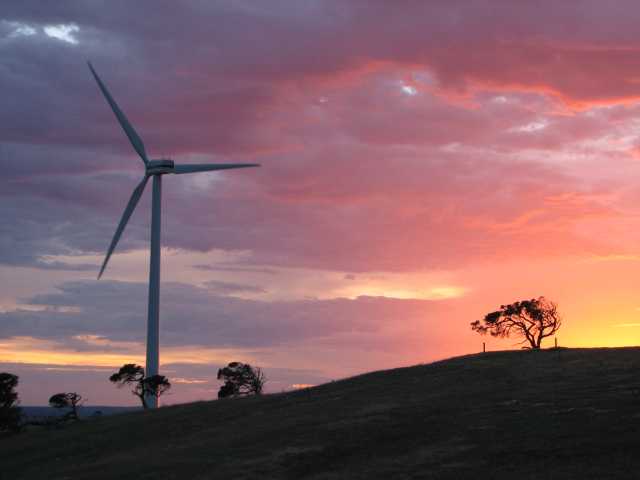
| | Canunda, near Millicent in SE SA
| |
Contrary to the tenor of the Liberal flyer, wind farms are
popular with
most rural people
A minority of people oppose wind farms, but many welcome the jobs, extra
farm income, additional business opportunities and investment.
The Central Western Daily (Orange) reported on 2011/12/05 that Blayney mayor
Bruce Kingham stated that "In the 11 years since the [Blayney] wind farm
[was built], we have had not one complaint"
Recent opinion surveys conducted by Pacific
Hydro and the CSIRO both showed strong support for wind power.
What the flyer doesn't say
SA's wind farms produce around
26% of SA's electricity
(in 2011) with a similar reduction in the amount of greenhouse gasses due to
electrical generation.
This is in spite of increasing electricity consumption, so wind power is a
very effective source of renewable energy.
The construction of wind farms is a great boost to regional businesses and
employment.
The continuing payments to farmers and maintenance workers during the
20-25 year life of the wind farms is a long-term benefit to regional
economies.
Many wind farm companies also make substantial regular donations to
community funds.
Another lie
The flyer claims that "Labor is planning to approve more and more wind farms
closer and closer to homes, villages and schools" (emphasis mine).
I am no fan of Labor, but I've been studying wind farms in Australia for a
number of years and I have seen no evidence of this.
|
Isobel Redmond (one time leader of the Liberal Opposition in South
Australia) has said that wind and solar power were a major cause of
rising electricity prices in South Australia.
That this is a lie is shown by a recent report by the Australian Energy
Market Commission which states that costs related to power distribution
accounted for 40% and wholesale component factors accounted for another
35% of price increases in SA.
The report also stated that Australia-wide costs related to the renewable
energy target contributed only 3% to electricity price rises.
(See
Are wind farms the cause of rising
electricity prices? for more information.)
| |
Liberals thinking of country people?
The December 2011 Liberal flyer on wind power tried to give the impression
that the Libs were thinking of the rights of country people.
If you have a look at Isobel Redmond's
contact page
you will see that she thinks so much about country South Australians that
she is under the impression that they all live in suburbs!
(She may have it changed after she reads this. Written 2012/01/24.)
|
|
On 2011/09/27 I inquired of Isobel Redmond's intentions in regard to wind power
should the Liberals win the next election.
The reply I had from her office (Kasia Jaruzelski) was:
"I can assure you that the Liberal Party have always believed that renewable
resources have a place in the generation of our electricity and should be
bought on line where feasible."
Judge this statement in the light of the
SA Liberal wind farm policy
made public in December 2011.
Also Ms Redmond was reported by Adelaide Now to have said on 2012/01/21,
"[Wind power is] probably the least efficient and most unreliable of all
the green energy sources".
What could she mean by 'least efficient'?
Efficiency in a fossil-fuelled power station, such as those that the Liberals
seem so keen on supporting, is very important.
Every tonne of coal that is burned causes around three tonnes of carbon
dioxide to be released into the atmosphere; so it is vitally important to
squeeze every Joule of useful energy out of that tonne of coal.
But how does it apply to the wind?
How would you meaningfully measure the
efficiency of a wind turbine?
If less than all the wind power available to the turbine is converted to
electricity, does it matter?
What harm is done?
Some wind farm opponents confuse efficiency with
capacity factor.
The capacity factor of Australian wind turbines averages out at 34%, which
means that for every 10 mega-Watts of installed capacity we get an average
of 3.4 MW of electricity.
The capacity factor of solar photovoltaics in SA is around 18%.
What could she mean by 'most unreliable'?
|
|
|
Wind turbines are 99% reliable
"The term reliability is generally used in energy policy circles as 'a
measure of how long a period of time occurs between failures of the machine
or how long those failures last'.
Wind turbines are extremely reliable.
They generally have reliability ratings of 99 per cent or more."
(From The Australia Institute, Wind Farms: The facts and the fallacies.)
|
|
Wind turbines are highly reliable, more so than the coal-fired generators
or nuclear power stations that Ms Redmond seems to prefer.
Yes, the wind is
variable, but it is
predictable, and since the whole of south-eastern Australia uses a common
electricity grid, a lull in the wind at one wind farm has very little effect
on the whole grid.
The variation in wind generation as a whole is slow and gradual so
it is easy for other generators to make up any short-fall.
By making such obviously ill-informed statements Ms Redmond is probably doing
more
harm to the Liberals and herself than she is to the renewable energy industry.
On 2012/01/24 I offered to sit down and talk to Ms Redmond about the facts
of wind power; as of late February I had not received any reply to my email.
|
|
| Brown Hill Range turbines
|
|---|
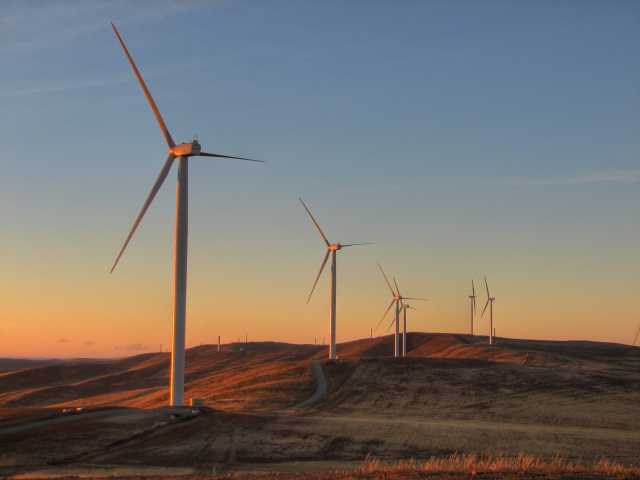
| | Wind turbines in early morning sunlight
| |
(Mr Ridgway has a
page devoted to him on this site.)
An acquaintance sent me a letter she had received from Mr Ridgway.
Among a number of dubious anti-renewable energy statements he said
"Homes and properties are often devalued when turbines are close and in
line-of-site".
There is no credible evidence for this statement, the
best surveys have suggested no decrease
in property values except for a short period around
the time that the wind farm was established.
Like so many anti-wind power people, Mr Ridgway made the point that wind
turbines
do not operate all
the time and therefore conventional power stations must be available to
fill in.
In this he conveniently forgot that all major power generators are
off line some of the time, either for maintenance or from breakdown.
Fossil fuel generators are typically available only 85% of the time.
Other generators must be available to fill these gaps too.
Both coal-fired and nuclear power stations are inflexible in generation,
they do not easily respond to varying demand on the grid.
Gas and oil-fired generators can be flexible, but are expensive to operate.
| |
| My photo used by the Liberals
|
|---|
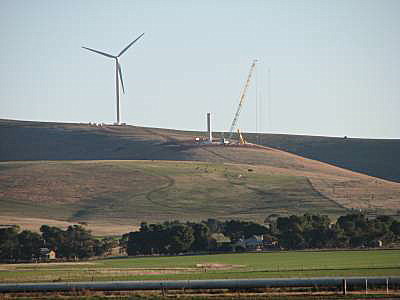
| | Construction of prototype turbine at Snowtown
| |
| |
Misleading information on photo
The caption under my photo used in the Liberal's brochure read
"Construction of the Snowtown wind farm in South Australia's mid north
dwarfs the house in the foreground, demonstrating how close to residents the
Government is willing to build wind turbines.
Photograph taken by Dave Clarke, February 19th 2011."
The turbine is about 1.8km from the house, making a lie of the statement
in the brochure.
|
|
As stated elsewhere on this page the
2km exclusion zone around homes that was
put into law in Victoria and NSW, and is favoured by the SA Liberal Opposition,
makes no sense at all except as a way of greatly limiting the growth of
sustainable energy in Australia.
So far as I know, no other country in the world has such a law.
Country people's quality of life should be protected, but this can be done,
should be done and has been done by legislating on maximum sound levels
rather than being based on an arbitrary distance.
The fact that the people who put the
SA Liberal Party flyers
together made so many errors, got most of their photos from the stridently
anti-renewable energy Waubra Foundation
and one of mine (without asking permission), and first said that they were
going to enforce a 5km exclusion zone around houses and later changed that
to 2km, suggests something thrown together with very little research,
objectivity, competence, diligence or care; not to mention low ethical
standards.
Contrary to the tenor of the Liberal flyer, wind power development has been
a
great success in SA, it
generates about 25% of SA's power and has substantially reduced power
imports from the eastern states and, very importantly, lowered greenhouse gas
emissions from power generation.
The flyers give the impression that wind power is unpopular in rural
districts.
As shown by the
Pacific
Hydro survey released in early 2012, the great majority of country people
are actually strongly in favour of wind power.
A few days before the Pac. Hydro report,
CSIRO released a report,
"Acceptance of Rural Windfarms in Australia: a snapshot".
Some of its key findings were:
- There is strong community support for wind farms;
- There is more support than suggested by media reports;
- Wind farmers might improve acceptance by developing a 'Social licence to
Operate' approach.
While the Liberals are doing all they can to support the fossil fuel
industry and discredit renewable energy, the Australian people generally
want renewables.
There is a huge amount of evidence that burning fossil fuels cause health
problems, but no-one with any credibility believes that wind farms do: see
Australian Medical
Association,
Doctors for the Environment
Australia,
Climate and Health Alliance.
In 2010 the NSW Government surveyed Community attitudes to wind farms and renewable energy in NSW;
81% of the people surveyed saw wind as an acceptable energy source, more than
any other energy source other than solar.
| |
| Wattle Point turbines
|
|---|
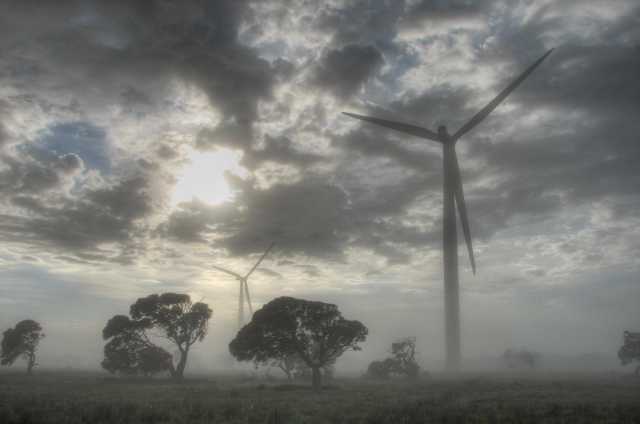
| | Turbines through mist; early morning
| |
Australians want action on climate change and it is only a small minority
of country people who oppose them, mainly on the NIMBY (not in my back yard)
principal.
Pacific Hydro and CSIRO reports released in 2012
In November 2011 Pacific Hydro
surveyed
attitudes to wind energy in ten communities across Victoria, NSW and SA where
wind farms were operating or proposed.
The main result was 83% support, 14% opposed, 3% undecided.
The CSIRO report "Acceptance of Rural
Windfarms in Australia: a snapshot"; found that there is strong community
support for wind farms (contrary to the impression given by the popular
media) and discussed ways of increasing this further.
Opinion Survey by Australian Wind Energy Association
The following was extracted from a Summary of Opinion Surveys on Wind Power
conducted by the European Wind Energy Association:
"The Australian Wind Energy Association commissioned a telephone survey in
August 2003 covering 1,027 people.
94% of respondents thought that a target to increase the contribution of
clean energy from renewable resources was a good (32%) or very good idea (62%).
Less than 3% considered the current target to be too high or much too high.
88% said they wanted the government to increase support to the renewable
energy sector, compared to 26% wanting an increase in support for the fossil
fuel sector.
95% supported (27%) or strongly supported (68%) building wind farms to meet
Australia's rapidly increasing demand for electricity.
91% agreed it was more important to build wind farms for electricity than
avoid building them in rural Australia.
For 71% of respondents, reducing greenhouse pollution outweighed protecting
industries that rely on reserves of fossil fuel."
Once the Liberal Party's agenda to destroy the Australian wind industry becomes widely known it will backfire on the Liberals.
| |
|
In Denmark, the country with the most wind power per capita, the minimum
distance between a wind turbine and a house must be four times the total
height of the turbine (including blades).
A typical maximum height is around 125m (in 2012), so under this rule
turbines would not be allowed closer than 500m to a house.
| |
The Canadians are considering national
guidelines on wind turbine spacing; 550m looks likely as the recommended
minimum distance between turbines and houses (January 2012).
|
|
Many people in Australia and around the world happily live closer to wind
turbines than 2km.
Wind farm operators must conform to sound level limits at homes pre-dating
wind farm construction and that is as it should be, but to give to the home
owner the power of vetoing any turbine within 2km of any house is
unjustified by the evidence and will cripple future development of wind power
in Australia.
There are already many constraints on where wind turbines can be built:
- They must be in a place that has a good wind resource; this often means
that they need to be on ridge lines or near the coast;
- They must be reasonably close to a high voltage power transmission line
with sufficient reserve capacity to take the power from the wind farm;
- They should be reasonably close to a number of other turbines to minimise
the length of roads and power cables etc;
- Their location must not be where there is high conservation-value
native vegetation;
- National and conservation parks cannot be used;
- Areas that have more than a few scattered houses are not practicable.
|
|
| Setbacks between wind turbines and houses internationally
|
|---|

| | Image credit: Minnesota Dept. Commerce and Katheryn M. B.
Haugen
| |
Imagine a proposed wind farm where there are houses scattered about three
of four kilometres apart; a situation not uncommon in rural areas.
If each of those houses has a 2km radius around it – an area of about
13 square kilometres – in which no turbine can
be built, a proposed wind farm will likely become unviable.
Most current wind farms have their turbines no closer than one kilometre
from homes; that means an exclusion zone of about three square kilometres
for each house.
A study of Wind Turbine Setbacks from
Residences for the Minnesota Department of Commerce by Katheryn M. B.
Haugen, 2011/10/19, showed that in most parts of the world mandated setbacks
between wind turbines and homes is 500m or 1km.
A figure in this study (Figure 2, page 26; graph on the right) showed no
jurisdiction that mandated a setback
as great as the 2kms mandated by several Australian State governments.
(Scotland mandates a distance of 2km from towns.)
It seems that the 2km setback in parts of Austalia is much more aimed at
slowing or stopping the development of renewable energy in Australia than
protecting people.
The Victorian rule of 5km from towns is plainly very much out of step with
international standards.
It seems that the IPA is too right wing and too opposed to climate science
for big donors like Shell and ExxonMobil, but still supported by the
Liberals.
Ben Schneiders and Royce Millar wrote an
article
in the Sydney Morning Herald:
"Some of the world's largest companies have dropped financial support and
membership of free-market think tank the Institute of Public Affairs, amid
concern at its vociferous campaign against action on climate change.
Petroleum giants ExxonMobil and Shell and large miners are among the
multinationals that have confirmed leaving the Liberal-linked institute, led
by party member John Roskam, who this year was praised by Opposition Leader
Tony Abbott.
Despite the loss of corporate support, Fairfax Media can reveal the
institute is now Australia's wealthiest private think tank after a surge in
donations and fund-raising from individuals who helped it double its revenue
in just four years."
The article also stated that the IPA is pushing for the privatisation of
the ABC.
More quotes from the SMH article:
Former prime minister John Howard said the institute was an important
influence on the Liberal Party, saying it "contributes very strongly to the
intellectual debate on issues and that in turn has an impact on what
attitude the Liberal Party takes."
British Tobacco has confirmed it is a financial member.
Mining magnate Gina Rinehart is a major supporter.
Rupert Murdoch has been a financial backer and an active member in the past.
However, Mr Murdoch's News Corp confirmed the company is not a member.
In a survey of 20 big companies, only British American Tobacco publicly
confirmed membership.
The institute has been a vocal critic of increased regulation of tobacco.
Philip Morris refused to confirm or deny membership.
Also see
SourceWatch.
The following was published on-line by the
Sydney Morning Herrald on 2009/12/07;
it is still true.
|
|
Honest politicians?
Wouldn't it be wonderful if members of the big parties spoke like this
consistently; saying what they believe with honesty and conviction, rather
than sticking to 'the party line', even when they believe it to be
'bullshit'?
|
|
"While a shadow minister, Tony Abbott, was never afraid of speaking bluntly
in a manner that was at odds with Coalition policy.
So as I am a humble backbencher I am sure he won't complain if I tell a few
home truths about the farce that the Coalition's policy, of lack of policy,
on climate change has descended into.
First, lets get this straight. You cannot cut emissions without a cost.
To replace dirty coal fired power stations with cleaner gas fired ones, or
renewables like wind let alone nuclear power or even coal fired power with
carbon capture and storage is all going to cost money.
To get farmers to change the way they manage their land, or plant trees and
vegetation all costs money.
Somebody has to pay.
So any suggestion that you can dramatically cut emissions without any cost
is, to use a favourite term of Mr Abbott, "bullshit."
Moreover he knows it.
The whole argument for an emissions trading scheme [ETS] as opposed to cutting
emissions via a carbon tax or simply by regulation is that it is cheaper -
in other words electricity prices will rise by less to achieve the same
level of emission reductions.
The term you will see used for this is "least cost abatement".
It is not possible to criticise the new Coalition policy on climate change
because it does not exist.
Mr Abbott apparently knows what he is against, but not what he is for.
Second, as we are being blunt, the fact is that Tony and the people who put
him in his job do not want to do anything about climate change.
They do not believe in human caused global warming.
As Tony observed on one occasion "climate change is crap" or if you consider
his mentor, Senator Minchin, the world is not warming, its cooling and the
climate change issue is part of a vast left wing conspiracy to
deindustrialise the world.
Now politics is about conviction and a commitment to carry out those
convictions.
The Liberal Party is currently led by people whose conviction on climate
change is that it is "crap" and you don't need to do anything about it.
Any policy that is announced will simply be a con, an environmental fig-leaf
to cover a determination to do nothing.
After all, as Nick Minchin observed, in his view the majority of the Party
Room do not believe in human caused global warming at all.
I disagree with that assessment, but many people in the community will be
excused for thinking the leadership ballot proved him right.
Remember Nick Minchin's defence of the Howard Government's ETS was that the
Government was panicked by the polls and therefore didn't really mean it.
Tony himself has in just four or five months publicly advocated the blocking
of the ETS, the passing of the ETS, the amending of the ETS and if the
amendments were satisfactory passing it, and now the blocking of it.
His only redeeming virtue in this remarkable lack of conviction is that
every time he announced a new position to me he would preface it with "Mate,
mate, I know I am a bit of a weather vane on this, but....."
Third, there is a major issue of integrity at stake here and Liberals should
reflect very deeply on it.
We have an Opposition whose current leadership dismisses the Howard
Government's ETS policy as being just a political ploy.
We have an Opposition Leader who has in the space of a few months held every
possible position on the issue, each one contradicting the position he
expressed earlier.
And finally we have an Opposition which negotiated amendments to the Rudd
Government's ETS, then reached agreement on those amendments and then, a
week later, reneged on the agreement.
Many Liberals are rightly dismayed that on this vital issue of climate
change we are not simply without a policy, without any prospect of having a
credible policy but we are now without integrity.
We have given our opponents the irrefutable, undeniable evidence that we
cannot be trusted."
Not that anyone would doubt it, but I will be voting for the ETS legislation
when it returns in February and if my colleagues have any sense they will do
so as well."
When Malcolm Turnbull became Prime Minister, his official stance on the
Liberal's policy on climate change action has greatly changed.
It seems that he has put his ethical standards to one side.
Why is it that Prime Ministers have ethical standards before and after their
time in the top job?
|
It seems that our Treasurer prefers the look of coal mines to wind farms.
|
| Beauty is in the eye of the beholder?
|
|---|
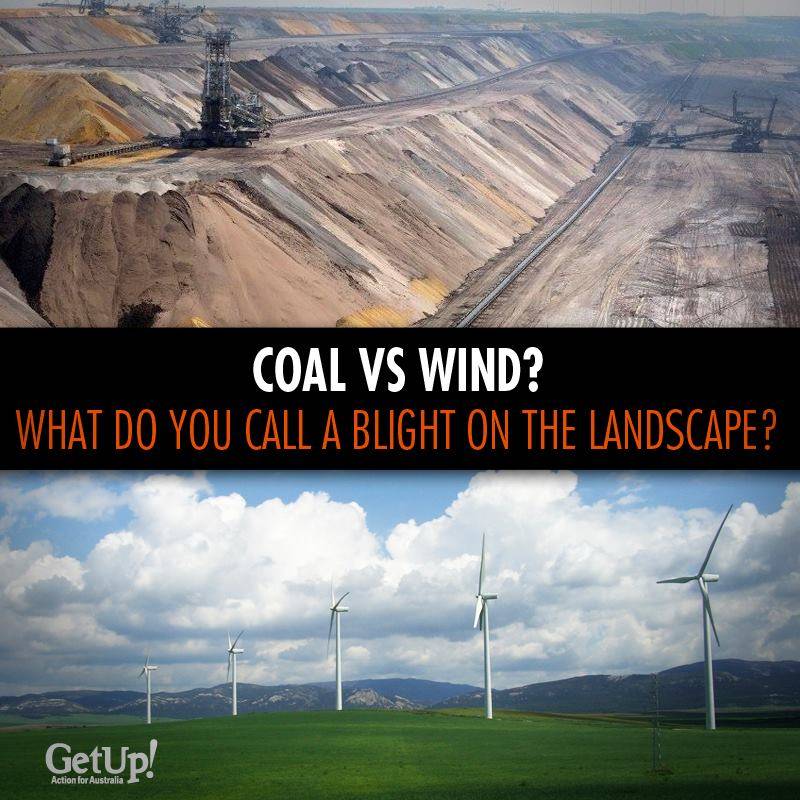
|
| |
Treasurer for sale
Is it surprising that Mr Hockey is looking after the obscenely wealthy fossil
fuel industry?
Sean Ncholls wrote an
article in the Sydney Morning Herald.
A quote:
"Treasurer Joe Hockey is offering privileged access to a select group
including business people and industry lobbyists in return for tens of
thousands of dollars in donations to the Liberal Party via a secretive
fund-raising body whose activities are not fully disclosed to election
funding authorities."
|
|
|
|
|
More on Treasurer for sale: 2014/05/05
Mr Hockey has instructed a law firm to pursue the SMH over this matter.
No doubt it will be the tax payers and not Mr Hockey who will be paying the
legal bills.
|
|
In a late April 2014 interview with Alan Jones, radio shock-jock, climate
science denier and
wind power critic on 2GB federal Treasurer Joe Hockey said:
"I drive to Canberra to go to parliament and I must say I find those wind
turbines around Lake George to be utterly offensive.
I think they're a blight on the landscape."
This was reported on The Guardian and elsewhere.
It would seem that Treasurer Hockey's aesthetic tastes differ from those of
most of us.
How many Australians would prefer to look at a coal mine rather than a wind
farm?
I'm sure there would be very few.
How many would rather live near a coal mine than a wind farm?
Perhaps Joe should ask the people of the Latrobe Valley where there was a
recent coal mine fire that caused huge air pollution problems?
From this, and other comments that Mr Hockey made to Jones, it looks like
the Australian Treasurer is preparing to reduce government support
for renewables in favour of the highly influential and filthy rich fossil
fuel industry.
We can expect little climate change action from this government.
One can only conclude that the Abbott Government is at the bec and call of
the fossil fuel industry.
| |
This section added
2023/11/14
|
|
Peter Dutton became leader of the federal Liberal Parliamentary party after Labor won the election of May 2022. At the time of writing this section he still held that position. He has to be one of the most uninspiring party leaders in Australian history, rivalling
Tony Abbott.
| |
I have promoted Mr Dutton
Shortly after writing this section I realised that Peter Dutton is a potential disaster to Australia's and the world's future of such magnitude as to deserve, not just a section on this page, but a page of his own.
|
|
As remarked on the ABC's
Media Watch on 2023/11/13, NewsDay quoted Peter Dutton as saying:
"When you look at the whales and the mother and the calf that we saw out there, the dolphins, all of that is at risk because there’s no environmental consideration of what these huge wind turbines — 260, 280 metres out of the water — will mean for that wildlife and for the environment."
I have written at some length on
another page about the myth that offshore wind farms kill whales.
So either Peter Dutton is ignorant or unethical, or both. He is either ignorant enough to not know that offshore turbines killing whales is a myth, or he is unethical enough to repeat lies when he believes it will serve his purpose to do so.
If Peter Dutton is the best man that the federal Liberal Parliamentary Party can find as leader they must be in a terribly desperate, sad and pathetic state.
Mr Dutton likes nuclear power. Does nuclear power make sense for Australia?
Mr Dutton is a great fan of nuclear power for Australia. I've written on how foolish and unrealistic this is
elsewhere on this page.
| |
Why do the Liberals push nuclear power?
The Australian Federal Liberal Party have been pushing nuclear power as the answer to both Australia's future energy needs and cutting emissions.
There could be three parts to the answer:
1. They hate renewable energy because it competes with their beloved fossil fuels;
2. They push nuclear to try to look like they are doing something to lower greenhouse emissions;
3. They know that it will take a long time to install nuclear power in any significant amount and their beloved fossil fuel power stations will be able to run all that time.
|
|
|
|
|
The Conversation
The Conversation offers "Academic rigour, journalistic flair". I have found it to be a very informative and, above all, reliable source of information. See their charter.
|
|
What are the facts?
I've written at some length about the shortcomings of nuclear power on another page on this site, but just one article published in The Conversation gives a very good summary of why nuclear power is quite unsuitable for Australia's needs.
Is nuclear the answer to Australia’s climate crisis?
The Conversation, written by Reuben Finighan, PhD candidate at the London School of Economics and Research Fellow at the Superpower Institute, The University of Melbourne.
A quote from the Conversation article:
There are four arguments against investment in nuclear power: Olkiluoto 3, Flamanville 3, Hinkley Point C, and Vogtle. These are the four major latest-generation plants completed or near completion in Finland, the United States, the United Kingdom and France respectively.
Cost overruns at these recent plants average over 300%, with more increases to come. The cost of Vogtle, for example, soared from US$14 billion to $34 billion (A$22-53 billion), Flamanville from €3.3 billion to €19 billion (A$5-31 billion), and Hinkley Point C from £16 billion to as much as £70 billion (A$30-132 billion), including subsidies. Completion of Vogtle has been delayed by seven years, Olkiluoto by 14 years, and Flamanville by at least 12 years.
Mr Finighan went on to give the current cost of nuclear power to be between Aus$220 and $350 per Megawatt hour (MWh) while the cost of wind and solar power to be between $35 and $45/MWh. Firming (that is, using energy storage to make the power available at any time) would add another $25 to $34/MWh. "In short, a reliable megawatt hour from renewables costs around a fifth of one from a nuclear plant."
As mentioned above, Australia ranks 53
rd in the world in population, but sixth in the world in the CO
2 produced by its electricity industry; it has 0.3% of the world's population, but produces 1.5% of the
world's greenhouse gasses; it is well up among the worst
greenhouse
polluters on the planet.
| |
Wind farms and health
Wind farms improve health by replacing polluting
coal-burning power stations that have very serious, and proven, effects on
health.
By opposing wind power and favouring fossil fuels the Liberals are causing
more illness from fossil-fuel pollutants in Australia.
|
|
All Australians, but especially those in positions of authority, have an
ethical
responsibility to reduce the harm we are doing to the planet.
I find it shocking that one of the major Australian political parties
could be so entirely lacking in ethical standards as are the
Liberal Party.
Climate change and ocean acidification, both largely caused by greenhouse
gasses, are, or will be, the greatest disasters in the history of humanity.
They will result in the displacement and possibly the deaths of hundreds
of millions or billions of people and the
extinction of thousands or even millions of species.
The Liberals in Australia and the Republicans in the USA are setting an
example to the rest of the world.
The USA and Australia are, per capita, the worst greenhouse polluters among
the OECD nations.
If the USA and Australia do next to nothing toward decreasing our huge
contribution
toward causing climate change, what sort of message does that send to the
rest of the world?
For the Liberals to not just fail to take significant and credible action
toward reducing fossil fuel use, but to actively campaign against sustainable energy, is a crime against humanity and the biosphere that would have to rank as worse than anything the generals have done in Burma, Sadam Husein in Iraq, or Assad in Syria.
| |
This section added
2024/03/15
|
|
While on the subject of ethics I'll note this dirty trick that the Tasmanian Liberals used to try to undermine the Jacqui Lambie Network in Tasmania just weeks before an election.
The URL of the Jacqui Lambie Network is https://lambienetwork.com.au/ while the URL of the fake Liberal web site that is critical of the Jacqui Lambie Network is https://lambienetwork.com/.
Monte Bovill wrote a piece on the dirty trick for the ABC that was posted on 2024/03/14.
| |
This section written
2024/06/14
|
|
Why the federal Liberals and Nationals so hate renewable energy is known best only to themselves, but a big part of the reason must have to do with some sort of agreement between them and the fossil fuel industries to support each other.
The justifications commonly given by politicians of the federal coalition for favouring fossil fuels include the following:
The lie | The truth
|
|---|
They claim that if we develop renewable energy at the rate called for by the Paris Accord we will cripple our economy
| Building wind and solar farms and energy storage systems by businesses will not be a cost to the public and will provide many jobs. The cost of providing new transmission lines are an investment that will pay for itself in time through cheaper electricity. The transition to renewables will be a boost to the economy rather than an impost.
|
They say without any supporting evidence that developing renewable energy will push the price of electricity up
| Wind and solar power is the cheapest new-build electricity generation, cheaper than coal and gas, and far cheaper than nuclear
|
A common red herring is the statement that China is the problem, not Australia
| China is a bigger emitter of greenhouse gasses than is Australia, and they have built many coal fired power stations. But China is building far more renewable energy than any other country and Australia's per-capita greenhouse gas production is far higher than is China's, so Australia has a moral responsibility to lower it emissions to catch up.
|
Some of the Liberals and Nationals say that nuclear is the answer to reducing emissions, not renewables. | Nuclear power is prohibitively expensive, very slow to build and almost always goes far over budget and takes longer to build than planned for. The coalition see it as a way of keeping coal fired power stations going longer and putting off renewable energy development. Nuclear power will never compete with renewables in Australia, it is simply a distraction that the Liberal/National coalition are using to support the existing old coal fired power stations and their owners.
|
The Liberal/National coalition say the cost of changing to renewables is too high and unjustified.
| The cost of limiting climate changing emissions will be far less than the cost of the consequences of doing nothing. Climate change is costing Australians at present in fires, floods, droughts and storms. If climate change is not controlled we will lose the Great Barrier Reef and other environmental assets that are big tourism earners. If we don't reduce our emissions quickly and substantially we risk becoming an international pariah.
|
| |
Written before Tony
Abbott became PM
|
|
Socrates was forced to take poison after being convicted of 'corrupting the
youth of Athens'.
His real crime was in asking too many embarrassing questions.
If Socrates was alive today in Australia perhaps we might hear a conversation
such as this.
Socrates is talking to Bruce, who has political ambitions.
Socrates: "Bruce, ever since I was brought back from the dead I've been
hearing about a thing called climate change.
Some people seem to think it's quite serious.
What do you think about it?"
Bruce: "Well Socs, when I read about it in the daily Murdoch I find that
everyone is quite unsure that it is real.
Rupert tells me that even the scientists are quite unconvinced.
Alan Jones says the same thing.
Surely they couldn't both be wrong? These are very wise men, great
philosophers."
Socrates turns to Bert.
(We brought Socrates back to life after more than two thousand years,
bringing Bertrand Russell back after just a few decades was a walk in the
park by comparison.)
"Bert, you are a bit more up to date on these things than I am, what do you
think about science and our craft, philosophy?"
Bert: "It seems to me that science has a much greater likelihood of being
true in the main than any philosophy hitherto advanced (I do not, of course,
except my own, or even yours Socs, or Alan's, Rupert's or Bruce's).
In science there are many matters about which people are agreed; in
philosophy there are none.
Therefore, although each proposition in science may be false, yet we shall
be wise to build our philosophy upon science, because the risk of error in
philosophy is sure to be greater than in science.
If we could hope for certainty in philosophy the matter would be otherwise,
but so far as I can see such a hope would be chimerical.
Bert went on; Bruce, I think you really need to listen to what the climate scientists themselves are saying, rather than listening to what Rupert says they are saying, and even Alan has been wrong sometimes."
[My apologies to Bert there, for taking some liberties.]
Socrates: "So Bruce, the country that you hope to lead is, I read, one of
the worst of the culprits in producing the greenhouse gasses that are
causing climate change.
Do you think that Australia and Australians have some responsibility to take
serious action, just in case Rupert might be wrong and the climate
scientists right?"
Bruce: "Well, you know, Australia only produces 1.5% of the world's
greenhouse gasses.
Even if we were to change to 100% renewable energy we'd have very little
effect on the world."
Socrates: "You are quite right there Bruce.
But I wonder, do you think there might be another way of looking at that
question?
Yes, Australia does only produce 1.5% of the greenhouse gasses, but then
Australia has only 0.3% of the world's population.
Another way of looking at it is that Australia ranks 53rd in the world in
population, but sixth in the world in the CO2 produced by its electricity
industry."
Bruce: "I don't quite follow Socs, what are you driving at?"
Socrates: "Well look at it this way Bruce.
If I was driving one of those motor cars that you modern people have
developed and I wanted to dispose of a copy of The Australian that I had
finished with, do you think it would be acceptable for me to throw it out
of the car window?
After all, I'd only be adding a negligible amount to the total of all the
litter on the roadsides.
If I refrain from throwing litter out of my car window I would have a
negligible effect on the total out there."
Bruce: "Ah, but that's quite different Socs.
It is not going to cost you anything to keep your daily Murdoch in the car
and dispose of it properly when you get to a bin.
If, when I'm running the country, I was to continue to tax the polluters it
would cost jobs and the punters would have to pay more for their
electricity."
Socrates: "Are you sure of that Bruce?
Any government relies on taxes.
I suppose you are going to continue to tax companies, personal incomes, and
motor fuels?
Why not tax carbon too? You could make it revenue-neutral if you wanted;
reduce some other taxes to compensate for the new tax money that you would
be getting from the polluters?
There are jobs in renewable energy too aren't there?
And I read that renewables are actually forcing the wholesale electricity
prices down."
Bruce: "Yeah but, no but, yeah but, the big polluters donate lots of dosh to
our campaign funds.
(They donate to the other lot too, I keep on telling them that we'll look
after them better than Labor will, but they insist on hedging their bets.)
We have a moral responsibility to look after the people who look after us,
don't we? That's what mateship is all about after all.
And then what about all the money that comes into the country from mining
and exporting coal.
If we, by taxing coal, show that we think it's on the nose, what message is
that giving to all the people who buy our coal?
They might think that they shouldn't be burning it either, and that would
hurt our economy; and there's nothing more important than the economy."
Socrates: "Bruce; what do you think about our responsibility to future
generations?
Do you think that the people who are running the world today have an
obligation to think of the world that they will be handing on to their
children and grandchildren?
If the climate scientists are right and Rupert and Alan are wrong, as
unlikely as that may seem to you, do you think we should make an effort to
look after the planet in the longer term?"
[Reader, I leave it to you to fill in what you think Bruce will answer to
this question.]
